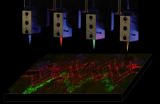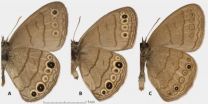(Press-News.org) 1. Scientists at A*STAR's Institute of Molecular and Cell Biology (IMCB) have identified the precise role of the protein, SNX27, in the pathway leading to memory and learning impairment. The study broadens the understanding of the brain's memory function and could be used to explain defects in the cognitive development of those with Down's syndrome. The newly established knowledge could potentially facilitate exploration of strategies to improve memory and learning abilities in Down's syndrome.
2. Down's syndrome is a genetic condition characterized by the presence of an additional copy of chromosome 21. About one in eight hundred new-borns is diagnosed with Down's syndrome. It is a condition that leads to impairments in both cognitive ability and physical growth that range from mild to moderate developmental disabilities. Yet, there is still no treatment for it.
3. In an earlier study published in Nature Medicine, an international team of scientists discovered that the additional copy of chromosome 21 in Down's syndrome reduces the production of SNX27 in the brain and results in synaptic dysfunction. Synapse, a structure that permits nerve cells to pass chemical signals to each other, is known to have an important role in memory formation and its dysfunction could result in impairment. By re-introducing SNX27 into the brain, memory could be restored hence suggesting that SNX27 is an essential protein for memory and learning.
4. The protein's role in the pathway leading to memory impairment, however, remained unclear until scientists from IMCB utilised live-cell imaging techniques to elucidate the mechanism of memory impairment and illustrated how SNX27 attributes to synaptic dysfunction. The scientists observed that transmission of chemical signals between the nerve cells are facilitated by AMPA-receptors and the activity occurs on the brain cell surface. As SNX27 plays an important role in shuttling the AMPA-receptor to the brain cell surface, lower levels of SNX27 means fewer receptors are carried to the surface, which consequently interrupts the signal transmission and impairs memory. This discovery was reported in the 24 January, 2014 issue of the renowned scientific journal, Nature Communications.
5. The correlation established between SNX27 levels and memory could explain why individuals with Down's syndrome encounter memory and learning difficulties. Identifying the target and its role is a crucial first step to therapy – having known the role of SNX27 in memory impairment, future research on Down's syndrome could focus on developing strategies which can effectively re-introduce the protein into the brain to restore memory and learning abilities.
6. Dr Loo Li Shen was an A*STAR scholar who is now working with Executive Director of IMCB, Prof Wanjin Hong, and is also an adjunct Assistant Professor at LKC medical school of NTU. The lead author of the Nature Communications paper and co-author of the Nature Medicine paper said, "Memory and the ability to learn capture the essence of life. Our research goes beyond the lab to make a difference by finding ways to grant these fundamental capabilities to those diagnosed with Down's syndrome. Our ultimate goal is to create a positive impact on the lives of these valuable children."
7. Prof Hong added, "In IMCB, we conduct research that would contribute to our understanding of mankind. This is a good example where the study is directed at a human condition - the Down's syndrome. The knowledge established from the findings could potentially translate into treatments for Down's syndrome or even become applicable to other similar human conditions."
INFORMATION:
Brain nerve cell studded with SNX27
(yellow-to-orange bulb-like structures)
(Image from Loo Li Shen, IMCB)
Notes for Editor:
The research findings described in this media release can be found in the 24 January, 2014 issue of Nature Communications Journal, under the title, "A role for sorting nexin 27 in AMPA receptor trafficking" by Li Shen Loo1,2, Ning Tang3, Muthafar Al-Haddawi1, Gavin Stewart Dawe3 & Wanjin Hong1,4,12 and the 24 March, 2013 issue of Nature Medicine Journal, under the title, "Loss of sorting nexin 27 contributes to excitatory synaptic dysfunction by modulating glutamate receptor recycling in Down's syndrome" by Xin Wang5,6, Yingjun Zhao5,7, Xiaofei Zhang5, Hedieh Badie8, Ying Zhou6, Yangling Mu9, Li Shen Loo1,2, Lei Cai1, Robert C Thompson5, Bo Yang5, Yaomin Chen5, Peter F Johnson10, Chengbiao Wu11, Guojun Bu7, William C Mobley11, Dongxian Zhang5, Fred H Gage9, Barbara Ranscht8, Yun-wu Zhang5,7, Stuart A Lipton5,11, Wanjin Hong1,4,12 & Huaxi Xu5,7
1Institute of Molecular and Cell Biology, Singapore 138673, Singapore.
2Lee Kong Chian School of Medicine, Nanyang Technological University, Singapore
637553, Singapore.
3Department of Pharmacology, Neurobiology and Ageing Programme, Singapore Institute for Neurotechnology, National University of
Singapore, Singapore 117597, Singapore.
4Department of Biochemistry, National University of Singapore, Singapore 117597, Singapore.
5Center for Neuroscience, Aging and Stem Cell Research, Sanford-Burnham Medical Research Institute, La Jolla, California, USA.
6Graduate School of Biomedical Sciences, Sanford-Burnham Medical Research Institute, La Jolla, California, USA.
7Fujian Provincial Key Laboratory of Neurodegenerative Disease and Aging Research, Medical College, Xiamen University, Xiamen, China.
8Tumor Microenvironment Program, Sanford-Burnham Medical Research Institute, La Jolla, California, USA.
9Laboratory of Genetics, The Salk Institute for Biological Studies, La Jolla, California, USA.
10Laboratory of Cancer Prevention, Center for Cancer Research, National Cancer Institute-Frederick, National Institutes of Health, Frederick, Maryland, USA.
11Department of Neurosciences, University of California San Diego, La Jolla, California, USA.
12Institute for Biomedical Research, School of Pharmaceutical Sciences, Xiamen University, Xiamen, China.
Correspondence for the Nature Communications publication should be addressed to L.S.L. (email: lsloo@imcb.a-star.edu.sg)
Correspondence for the Nature Medicine publication should be addressed to H.X. (xuh@sanfordburnham.org or hxxu@xmu.edu.cn)
Full text of the Nature Communication article can be accessed from http://www.nature.com/ncomms/2014/140124/ncomms4176/full/ncomms4176.html
Full text of the Nature Medicine article can be accessed from http://www.nature.com/nm/journal/v19/n4/full/nm.3117.html
AGENCY FOR SCIENCE, TECHNOLOGY AND RESEARCH (A*STAR)
For media queries and clarifications, please contact:
Tan Yun Yun (Ms)
Senior Officer, Corporate Communications
Agency for Science, Technology and Research
Tel: (+65) 6826 6273
Email: tan_yun_yun@a-star.edu.sg
About Institute of Molecular and Cell Biology (IMCB)
The Institute of Molecular and Cell Biology (IMCB) was established in 1987 at the National University of Singapore (NUS) before becoming an autonomous research institute (RI) of A*STAR and moving to Biopolis in 2004. IMCB strives to maintain the scientific excellence of PI-driven research and at the same time aims to promote collaborative team-based projects of medical and industrial relevance.
Funded primarily by the Biomedical Research Council (BMRC) of A*STAR, IMCB's research activities focus on four major fields: Animal Models of Development and Disease, Cancer Genetics and Therapeutics, Cell Biology in Health and Disease, and Structural Biology and Drug Discovery.
For more information about IMCB, please visit http://www.imcb.a-star.edu.sg.
About the Agency for Science, Technology and Research (A*STAR)
The Agency for Science, Technology and Research (A*STAR) is Singapore's lead public sector agency that fosters world-class scientific research and talent to drive economic growth and transform Singapore into a vibrant knowledge-based and innovation driven economy.
In line with its mission-oriented mandate, A*STAR spearheads research and development in fields that are essential to growing Singapore's manufacturing sector and catalysing new growth industries. A*STAR supports these economic clusters by providing intellectual, human and industrial capital to its partners in industry.
A*STAR oversees 18 biomedical sciences and physical sciences and engineering research entities, located in Biopolis and Fusionopolis, as well as their vicinity. These two R&D hubs house a bustling and diverse community of local and international research scientists and engineers from A*STAR's research entities as well as a growing number of corporate laboratories.
For more information about A*STAR, please visit http://www.a-star.edu.sg.
A*STAR scientists discover protein's role in human memory and learning functions
Deficiency in SNX27 could explain the learning difficulties in Down's syndrome
2014-02-19
ELSE PRESS RELEASES FROM THIS DATE:
Could metabolism play a role in epilepsy?
2014-02-19
VIDEO:
The Kuehner lab demonstrates their drug-screening technique in JoVE's peer-reviewed video format to aid other researchers in the field.
Click here for more information.
February 19—Researchers from the Franciscan University of Steubenville, Ohio are exploring a possible link between metabolic defects and seizures. They determined that diet could influence susceptibility to seizures, and they have identified a common diabetes drug that could be useful in treating disorders ...
An essential step toward printing living tissues
2014-02-19
BOSTON — A new bioprinting method developed at the Wyss Institute for Biologically Inspired Engineering at Harvard University and the Harvard School of Engineering and Applied Sciences (SEAS) creates intricately patterned 3D tissue constructs with multiple types of cells and tiny blood vessels. The work represents a major step toward a longstanding goal of tissue engineers: creating human tissue constructs realistic enough to test drug safety and effectiveness.
The method also represents an early but important step toward building fully functional replacements for injured ...
Antidepressant holds promise in treating Alzheimer's agitation
2014-02-19
Feb. 19, 2014 (Toronto) - An antidepressant medication has shown potential in treating symptoms of agitation that occur with Alzheimer's disease and in alleviating caregivers' stress, according to a multi-site U.S.- Canada study.
"Up to 90 per cent of people with dementia experience symptoms of agitation such as emotional distress, restlessness, aggression or irritability, which is upsetting for patients and places a huge burden on their caregivers," said Dr. Bruce G. Pollock, Vice President of Research at the Centre for Addiction and Mental Health (CAMH), who directed ...
'Beautiful but sad' music can help people feel better
2014-02-19
New research from psychologists at the universities of Kent and Limerick has found that music that is felt to be 'beautiful but sad' can help people feel better when they're feeling blue.
The research investigated the effects of what the researchers described as Self-Identified Sad Music (SISM) on people's moods, paying particular attention to their reasons for choosing a particular piece of music when they were experiencing sadness - and the effect it had on them.
The study identified a number of motives for sad people to select a particular piece of music they perceive ...
Stratification determines the fate of fish stocks in the Baltic Sea
2014-02-19
With its narrow connection to the North Sea, strong currents, a large number of river estuaries and a bottom profile marked by ridges, basins and troughs, the Baltic represents an inland sea with highly different water qualities. The fact that these morphological and hydrographic conditions can also influence the fate of fish stocks has now been shown by a team of fisheries biologists from GEOMAR Helmholtz Centre for Ocean Research Kiel and the National Institute of Aquatic Resources (DTU Aqua) at the Technical University of Denmark. For their publication in the international ...
Dreams, deja vu and delusions caused by faulty 'reality testing'
2014-02-19
New research from the University of Adelaide has delved into the reasons why some people are unable to break free of their delusions, despite overwhelming evidence explaining the delusion isn't real.
In a new paper published in the journal Frontiers in Psychology, University of Adelaide philosopher Professor Philip Gerrans says dreams and delusions have a common link – they are associated with faulty "reality testing" in the brain's higher order cognitive systems.
"Normally this 'reality testing' in the brain monitors a 'story telling' system which generates a narrative ...
A challenge to the genetic interpretation of biology
2014-02-19
A proposal for reformulating the foundations of biology, based on the 2nd law of thermodynamics and which is in sharp contrast to the prevailing genetic view, is published today in the Journal of the Royal Society Interface under the title "Genes without prominence: a reappraisal of the foundations of biology". The authors, Arto Annila, Professor of physics at Helsinki University and Keith Baverstock, Docent and former professor at the University of Eastern Finland, assert that the prominent emphasis currently given to the gene in biology is based on a flawed interpretation ...
Two new butterfly species discovered in eastern USA
2014-02-19
Butterflies are probably best-loved insects. As such, they are relatively well studied, especially in the United States. Eastern parts of the country are explored most thoroughly. First eastern US butterfly species were described by the father of modern taxonomy Carl Linnaeus himself, over 250 years ago. For the last two and a half centuries, naturalists have been cataloguing species diversity of eastern butterflies, and every nook and cranny has been searched. Some even say that we learned everything there is to know about taxonomy of these butterflies.
Discovery of ...
Targeted treatment for ovarian cancer discovered
2014-02-19
Researchers at Women & Infants Hospital of Rhode Island have developed a biologic drug that would prevent the production of a protein known to allow ovarian cancer cells to grow aggressively while being resistant to chemotherapy. This would improve treatment and survival rates for some women.
The work coming out of the molecular therapeutic laboratory directed by Richard G. Moore, MD, entitled "HE4 (WFDC2) gene overexpression promotes ovarian tumor growth" was recently published in the international science journal Scientific Reports, a Nature publishing group.
"We ...
UNH research: Most of us have made best memories by age 25
2014-02-19
DURHAM, N.H. – By the time most people are 25, they have made the most important memories of their lives, according to new research from the University of New Hampshire.
Researchers at UNH have found that when older adults were asked to tell their life stories, they overwhelmingly highlighted the central influence of life transitions in their memories. Many of these transitions, such as marriage and having children, occurred early in life.
"When people look back over their lives and recount their most important memories, most divide their life stories into chapters ...
LAST 30 PRESS RELEASES:
Sports injuries sustained during your period might be more severe
World's first successful 2 Tbit/s free-space optical communication using small optical terminals mountable on satellites and HAPS
Can intimate relationships affect your heart? New study says ‘yes’
Scalable and healable gradient textiles for multi‑scenario radiative cooling via bicomponent blow spinning
Research shows informed traders never let a good climate crisis go to waste
Intelligent XGBoost framework enhances asphalt pavement skid resistance assessment
Dual-function biomaterials for postoperative osteosarcoma: Tumor suppression and bone regeneration
New framework reveals where transport emissions concentrate in Singapore
NTP-enhanced lattice oxygen activation in Ce-Co catalysts for low-temperature soot combustion
Synergistic interface engineering in Cu-Zn-Ce catalysts for efficient CO2 hydrogenation to methanol
COVID-19 leaves a lasting mark on the human brain
Scientists use ultrasound to soften and treat cancer tumors without damaging healthy tissue
Community swimming program for Black youth boosts skills, sense of belonging, study finds
Specific depressive symptoms in midlife linked to increased dementia risk
An ‘illuminating’ design sheds light on cholesterol
Who is more likely to get long COVID?
Study showcases resilience and rapid growth of “living rocks”
Naval Research Lab diver earns Office of Naval Research 2025 Sailor of the Year
New Mayo-led study establishes practical definition for rapidly progressive dementia
Fossil fuel industry’s “climate false solutions” reinforce its power and aggravate environmental injustice
Researchers reveal bias in a widely used measure of algorithm performance
Alcohol causes cancer. A study from IOCB Prague confirms damage to DNA and shows how cells defend against it
Hidden viruses in wastewater treatment may shape public health risks, study finds
Unlock the power of nature: how biomass can transform climate mitigation
Biochar reshapes hidden soil microbes that capture carbon dioxide in farmland
Reducing saturated fat intake shows mortality benefit, but only in high-risk individuals
Manta rays create mobile ecosystems, study finds
Study: Mixed results in using lipoic acid to treat progressive multiple sclerosis
Norbert Holtkamp appointed director of Fermi National Accelerator Laboratory
New agentic AI platform accelerates advanced optics design
[Press-News.org] A*STAR scientists discover protein's role in human memory and learning functionsDeficiency in SNX27 could explain the learning difficulties in Down's syndrome



